Toro Rosso launches 2009 car
THE TEAM
 |
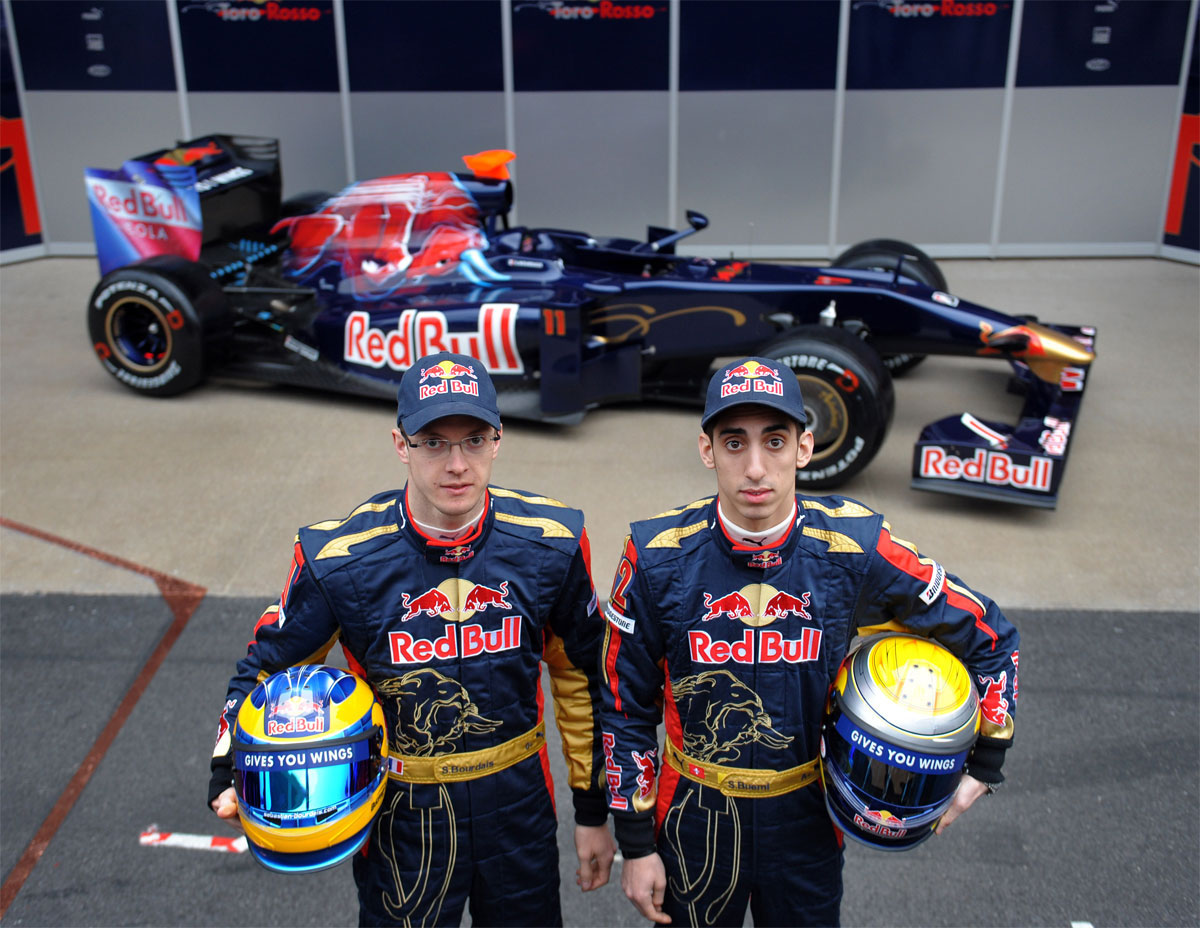 |
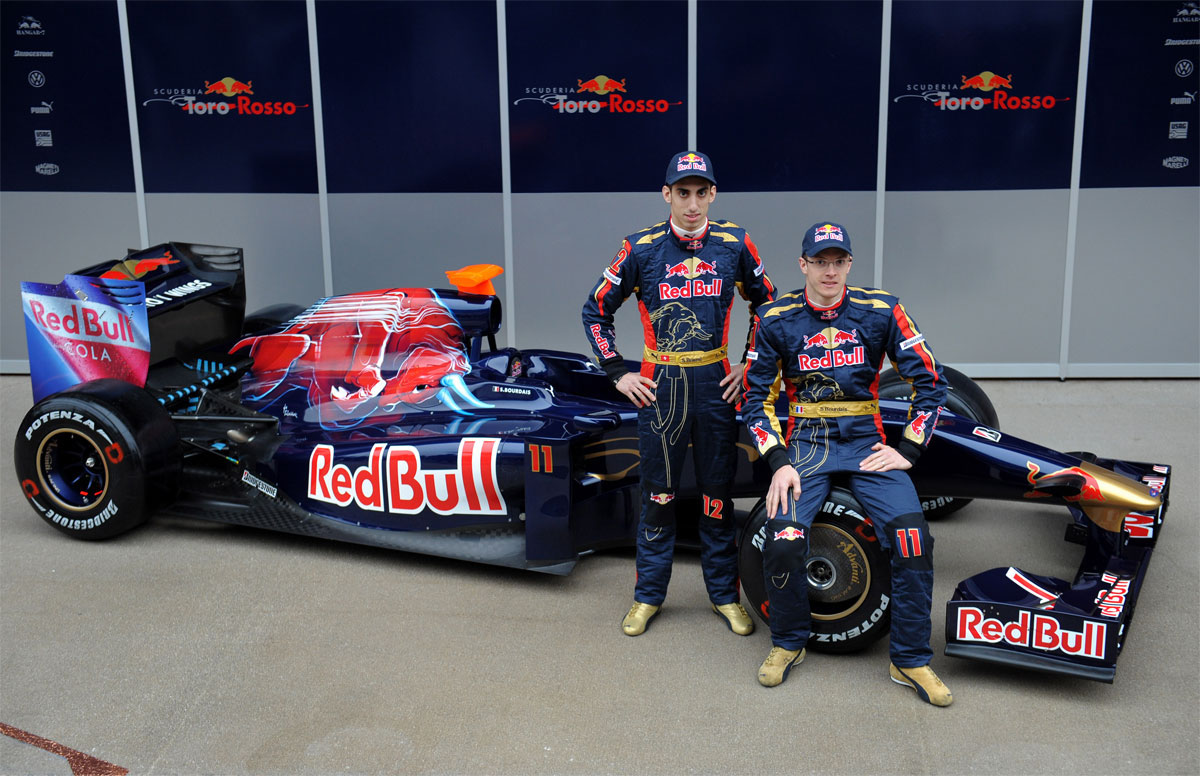 |
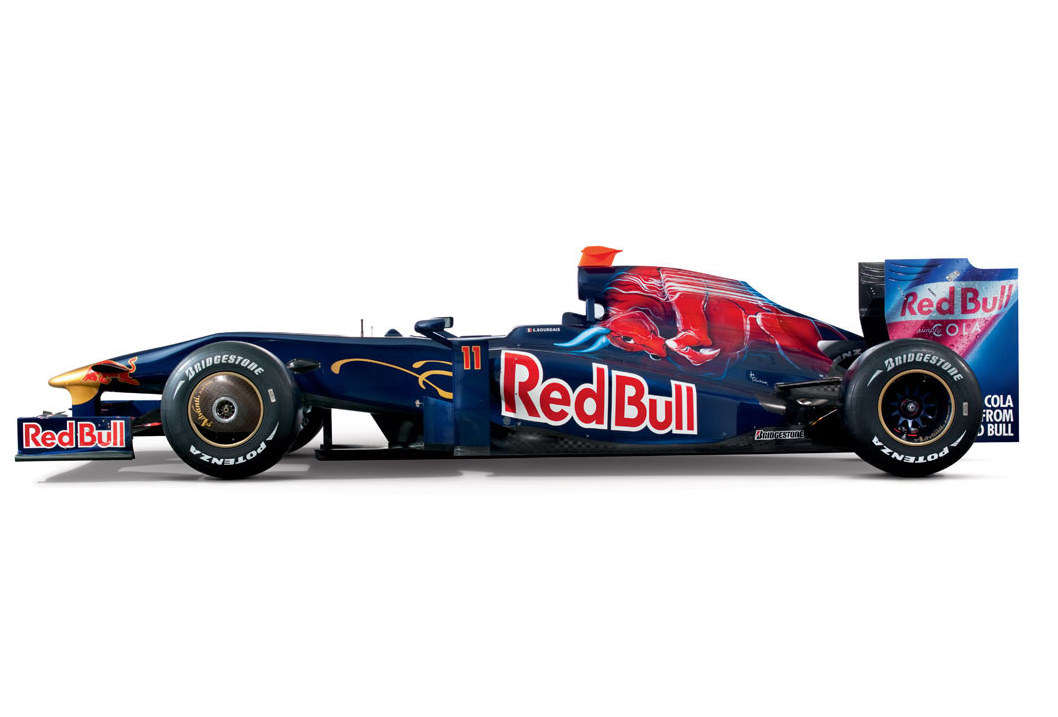 |
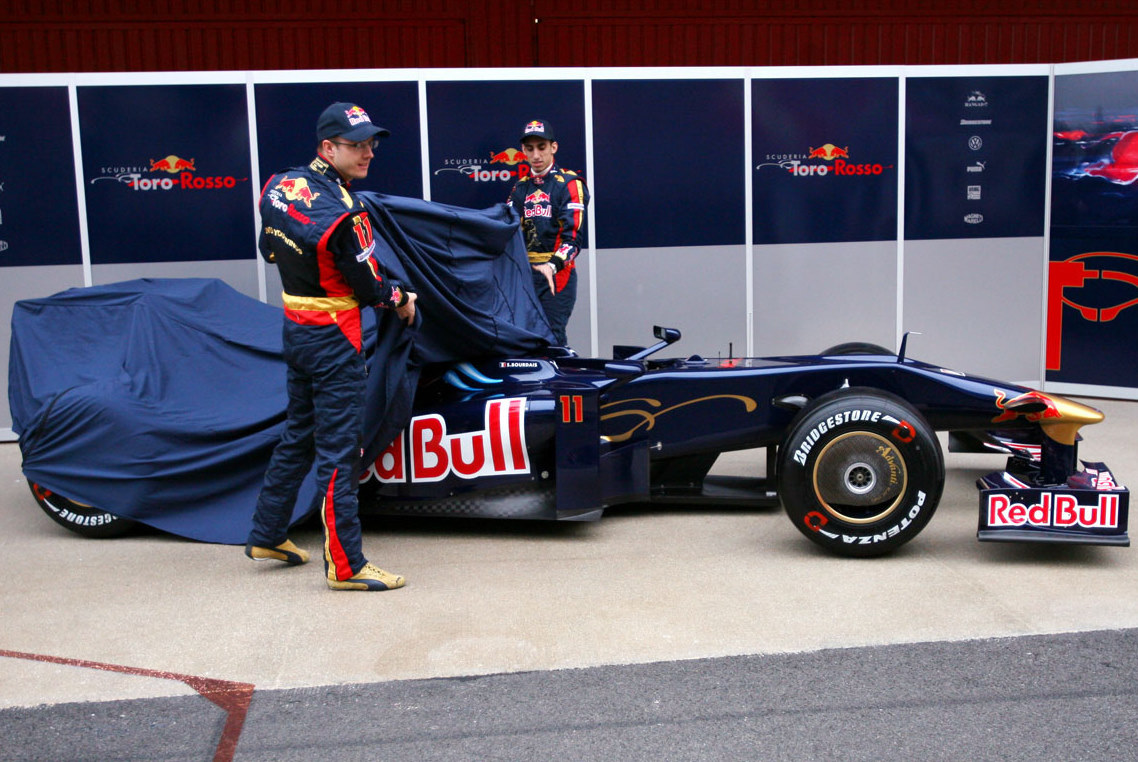 |
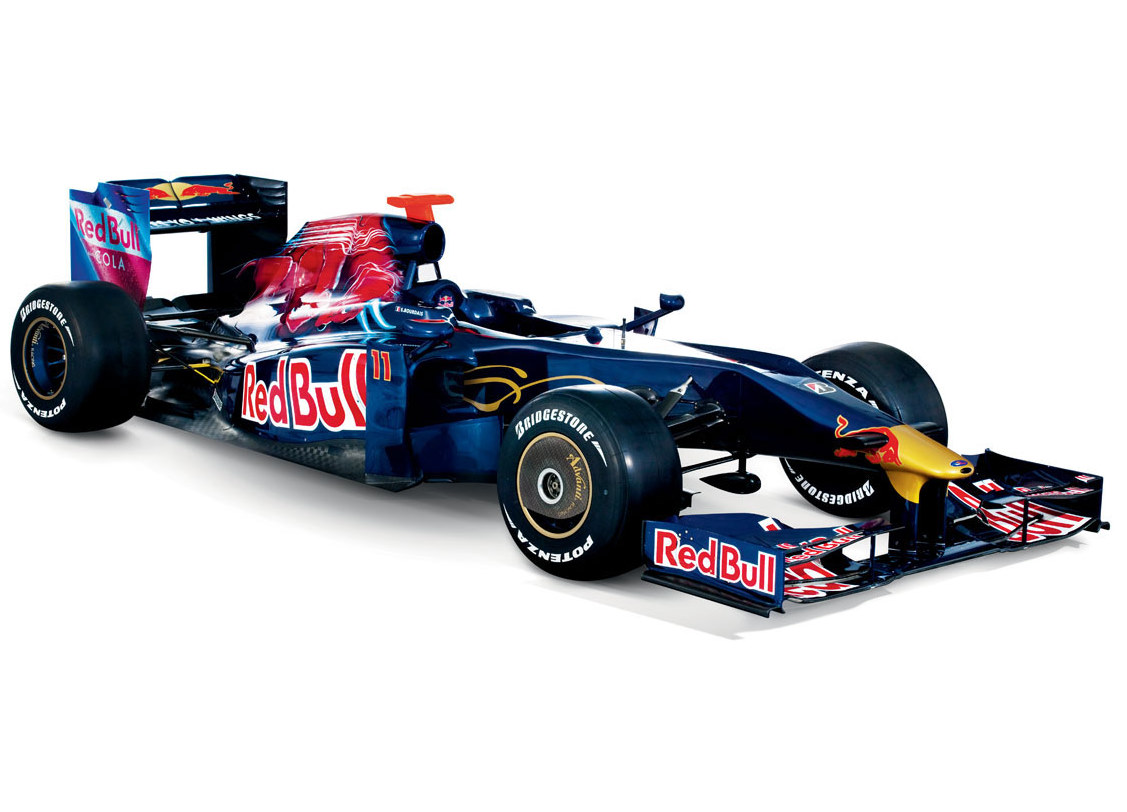 |
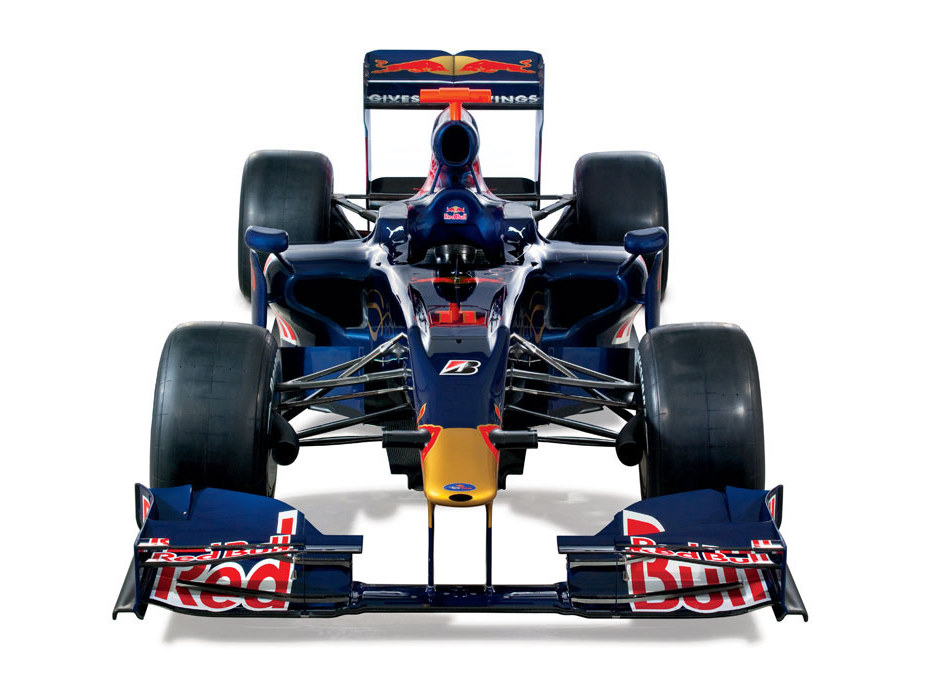 |
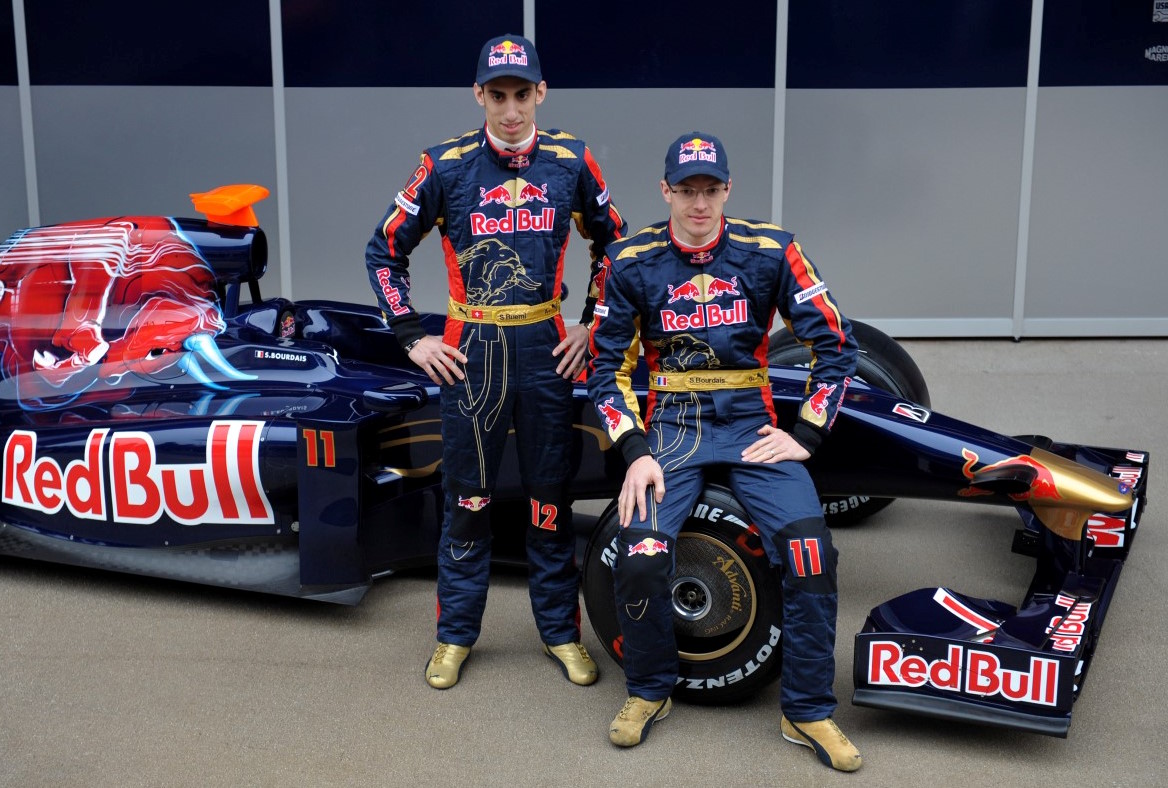 |
| Toro Rosso STR4 |
SCUDERIA TORO ROSSO
Scuderia Toro Rosso tackles its fourth season in Formula One with a lot to live up to, having finished sixth in the 2008 Constructors’ Championship, with a best ever points haul of 39, thanks in part to the team’s first win at the Italian Grand Prix. Red Bull was very much the hot topic in 2005, its maiden year in F1, and grabbed the headlines all the way through the season, ending with the announcement it had bought the Minardi team to create Scuderia Toro Rosso.
Red Bull’s motives in taking over the team were prompted by the need to find cockpits for the most talented of the rookie drivers emerging from its Young Driver Program, or maybe because it just liked pissing people off by buying a second team.
Sebastian Vettel last year ably demonstrated the effectiveness of the young driver concept, and it is hoped that success will be carried on this season with the arrival of the even younger Sébastien Buemi. Continuity is important in Formula One and we still have Franz Tost at the helm and Giorgio Ascanelli heading the technical operation, while Sébastien Bourdais brings stability to our driver line-up. It also means we can carry on referring to our driver pairing as ‘Seb ‘n’ Seb’.
THE CAR
STR4 TECHNICAL SPECIFICATION
Official car name: STR4 Engine: Ferrari V8 Type 056 Chassis material: Composite monocoque structure Bodywork material: Carbon fiber composite Front Suspension: Upper and lower carbon wishbones, torsion bar springs and anti roll bars, Sachs dampers Rear Suspension: Upper and lower carbon wishbones, torsion bar springs and anti roll bars, Sachs dampers Steering: Scuderia Toro Rosso Gearbox: Seven-speed hydraulic Clutch: Sachs Triple-plate pull-type KERS: Ferrari design in conjunction with Magneti- Marelli Calipers: Brembo Pads and discs: Brembo Cooling system (radiators, heat exchangers): Scuderia Toro Rosso Cockpit instrumentation: Scuderia Toro Rosso Seat belts: Willans Steering wheel: Scuderia Toro Rosso Driver’s seat: Carbon fiber construction, molded to driver’s shape Extinguisher system: Scuderia Toro Rosso/FEV Wheels: Advanti Racing Fuel cell: ATL Overall Weight: >605 kg (including driver and camera)
THE MANAGEMENT
FRANZ TOST – TEAM PRINCIPAL
Franz Tost has been steering the ship since Toro Rosso started racing in 2006. We stepped up onto the bridge to quiz the captain.
Franz, how does Toro Rosso at the start of the 2009 season compare with the start of 2008?
“This year is already looking great as we are five races ahead of schedule, given that last year we did not get to race the ’08 car until the sixth round of the season – in Monaco! But seriously, with the continued support of Red Bull, Scuderia Toro Rosso has grown in several ways in the past 12 months. The team is bigger, having expanded its facility in Faenza and we have taken on more staff. The 2008 season was good in terms of our on-track performance, which, it’s fair to say, exceeded our expectations, with our biggest ever haul of points, a pole position and a win. It’s going to be tough to live up to that this year. While the rules have changed, within the team we can rely on a good level of stability, as all the key players on the technical side have been in place for some time now and so understand how to make progress, working together. The other element of our package that remains the same is the support we receive from Red Bull Technology. And right from Red Bull Racing’s first test in Jerez it appeared that the car was competitive straight away and that Adrian Newey and his team had come up with a very promising package. The car looks good and shows very promising performance.
“This year marks the third year of our collaboration with Ferrari, which, on both a human and technical level, works very well and it goes without saying that having an engine that won the 2008 Constructors’ World Championship can only be a good thing. As for our driver pairing, in 2008 we effectively started the season with two F1 novices, but this time, Bourdais has 18 grands prix under his belt, and this year’s rookie, Buemi, has already shown well in winter testing."
How will the rule changes, technical and sporting, affect the team?
“At Toro Rosso, we support the cost-cutting initiatives instigated by the FIA and FOTA. These are a good thing for a small team like ours, as for example, the reduction in the use of wind tunnel time and Computational Fluid Dynamics has had a minimal effect on our work. In terms of manpower, it means we have not had to let many people go, allocating test team staff to other roles within the company. As everyone feels the effects of a worldwide recession, it is only right that Formula One is seen to acknowledge this and act accordingly, to allow the sport to flourish in a more sensible and less extravagant fashion than in the past.
“Looking at the major changes to the technical regulations, these do have a downside for us, because historically, whenever rules have changed significantly, it is always the bigger, more established teams who have the technical resources and experience to react quickly in adapting to those changes. It was the long period of stability in the rules which allowed Toro Rosso to be so competitive last year."
Your driver line-up?
“I mentioned the benefit of consistency in our technical line-up and we also have a level of consistency in our driver line-up, as Sébastien Bourdais tackles his second season in Scuderia Toro Rosso colors. In 2008, he produced some good performances in the races and in qualifying, but he was also unlucky at times. We expect him to benefit from the experience he gained last year: he knows the team, the circuits and the F1 environment and this will allow him to tackle the season with confidence. He will also surely enjoy the return to slick tires, which better suit his driving style. As for the other driver, Sébastien Buemi, who comes from the Red Bull Young Driver program, he has shown himself to be naturally talented with plenty of speed and, more importantly he is a quick learner. Having invested in his early career Red Bull is keen to see him progress at the top level of the sport. He faces a steep learning curve, but we should not forget he is still very young – he even makes Vettel look like a veteran!"
What are the team’s targets for the year?
“All race teams should have the same targets: to win every race they enter! Of course, this is not going to happen and even matching our 2008 showing will be difficult, as the sport enters a new era. Therefore our target has to be to leave every race track on a Sunday night, knowing we have done the best job we could. The results will then depend on how everyone else has done."
Franz Tost – Biography
As a young lad, Franz Tost’s big hero was Jochen Rindt: his bedroom walls were covered with posters of the Austrian ace and when it was dissertation time at school, Franz’s classmates would all groan, as they knew what was coming – another bloody eulogy to Rindt. Inevitably, Tost found himself behind the wheel, racing a Formula Ford. He was quick enough to win the 1983 Austrian FF Championship, but he felt he would not make it to the top as a driver so a degree in Sports Management from Innsbruck University was next on the agenda. This led to a job at the highly-rated Walter Lechner Racing School at the Zeltweg circuit.
From there Tost moved to a team management role with EUFRA Racing and at the end of 1993, he took the post of team manager with Willi Weber’s Formula 3 team. It was here that he crossed paths with Ralf Schumacher and Weber asked Tost to accompany the youngster to Japan. This led to looking after Ralf’s interests at Jordan and then Williams, prior to taking on the role of Operations Manager with BMW’s Formula 1 program. From there, he took on the role of Team Principal with the newly formed Scuderia Toro Rosso in 2005.
GIORGIO ASCANELLI – TECHNICAL DIRECTOR
It’s a common misconception that before the start of the season a big truck turns up in Faenza from Milton Keynes, its back door folds down and, hey presto, a fully-built Toro Rosso car rolls out. In fact, Scuderia Toro Rosso has far more control over its technical destiny, right from the design stage through to construction. Technical Director Giorgio Ascanelli explains:
“Red Bull Technology does extremely significant work in defining the essential characteristics of the new car: its length, wheelbase, weight distribution, its basic metric characteristics. However, with any F1 car, the packaging revolves around an engine and peculiarities from the drivers and, as we run a different engine to our sister team, it involves a different fuel system and fuel tank. Therefore, ours is completely different to the Red Bull Racing car and is designed here by us.
“The same goes for the water and oil systems linked to the engine. Different engines have different heat rejection and different operating temperatures, with materials specified to different levels. Also, the tolerances, which you have to respect when building an engine, are tuned in such a way that an engine works at its best within a defined temperature range. This in itself conditions the radiators and also all of the internal aerodynamics. That then impacts on the aero side and this work is also done in Faenza.
“The engine mates to a gearbox via some fixings and a clutch. Here again the clutch installation is completely different between the two cars. In fact, the clutch itself is very different and the work of installing clutch and gearbox is also completely done in Faenza, involving a casing designed in Faenza and using completely different technology to the one Red Bull Technology provides to Red Bull Racing. The same goes for the oil and water radiators and the entire hydraulic and electronic systems.
“It’s going to be an interesting season. I think it’s good that the guys here in Faenza get the chance to control their own destiny in a way, but at the moment, we only have about a dozen people on the design side, so we’re a decade out in terms of manpower!"
Giorgio Ascanelli – Biography
From Ferrara, Italy, Giorgio has pretty much done it all in a motor sport career that dates back to 1985, when he worked as a calculation engineer at Ferrari. That was followed by a brief spell rallying with Abarth and then three years as Gerhard Berger’s race engineer with the Scuderia (the big red team, not Toro Rosso!)
He then moved to Benetton, engineering world champion Nelson Piquet before rejoining Berger at McLaren where he also engineered Ayrton Senna in 1993. Soon it was time to return to Ferrari, again working with Gerhard and also Jean Alesi. Ascanelli then moved away from the race tracks and built up Maserati’s very successful sports car racing program from scratch. But when you have had the F1 virus, it stays with you for life and Ascanelli returned to the grand prix scene to head up Scuderia Toro Rosso’s technical operation for the start of 2008. Giorgio lists tennis as one of his hobbies saying, “I can go from pre-game warm-up to total exhaustion without playing a single point!"
GIANFRANCO FANTUZZI – TEAM MANAGER
This year, Gianfranco is our Team Manager, but it’s in his previous role, in charge of the production side at Scuderia Toro Rosso, that Fantuzzi takes us through the build of the 2009 car.
“If you take parts manufactured in the factory or purchased directly by us, almost 100 percent of the car is made in-house. Our procurement department processes 14,000 drawings, including those for car components, jigs, tooling, assembly and so on," says the former General Manager at the team.
The most obvious increase in home production is in the Composites Department.
“At first, we decided to make a few parts in our own composites department, but for the first time ever, we have now made the actual chassis in-house, whereas last year it was produced by Carbotec in Austria. This has been a big challenge for us and the chassis took up 100 percent of our energy up to the start of the season. It involved re-commissioning the original autoclave that has been here since before the Toro Rosso name went up over the door. We also had to take on more staff with good qualifications in the fields of laminating and trimming. In fact, before tackling STR4, we actually made a 2008 STR3 chassis to see how it would work out and that proved to be a very valuable experience."
The factory itself has grown, with an additional building shaping up to be the new machine shop, while additional staff have joined on the design and composites side. As for the team’s future expansion, a lot will depend on how the sport’s rules determine just what constitutes a manufacturer and constructor in Formula One.
Gianfranco Fantuzzi – Biography
This is the second Faenza era for Team Manager Fantuzzi, as he worked here with Minardi from 1998 to 2001 as a race engineer, before joining Scuderia Toro Rosso in 2006. This year, he takes on a new role, relinquishing the job of General Manager to return to the race tracks as Team Manager.
Like all young boys living in Modena, he was infected with the racing virus at an early age and joined Ferrari as a mechanic when he was just 16-years-old. He spent 22 years with the Prancing Horse, most of that time working as an engineer on the test and race team. He also took a break from Formula One, moving to the United States to get involved with the company’s IMSA program.
“When I was young, I used to go karting, but I did just enough to know that I was much too slow," says Gianfranco. “I always preferred what goes on behind the scenes in racing and so, after race engineering at Minardi, I moved to the role of Logistics Manager with the Toyota F1 team." However, a few years ago, he returned to his spiritual home and is looking forward to his new role within the team.
LAURENT MEKIES – CHIEF ENGINEER
The most dramatic set of rule changes for 20 years will put a new complexion on how teams tackle a race weekend. Our Chief Engineer, Laurent Mekies talks us through them.
“The arrival of slick tires, big aero changes and a ban on testing means that basing our race weekend preparation on the previous year’s race will be much less relevant than in the past, although our knowledge of each circuit still remains the same.
“Some of these missing elements can be replaced with more simulation work and as the season progresses, our understanding of all the new elements will increase, allowing us to make judgment calls on what is required. More than ever, Friday becomes a test day, not just in terms of preparing for that weekend. In addition, you will have to allocate part of your program to your car development that was previously done at test sessions in between the races. This will require a rethink of the program, which, usually on Fridays, could be rather repetitive for the spectators. Now you will see a lot more running with different programs split between the two drivers.
“As for KERS, our system comes from Ferrari and we will work with them so that we both make progress as rapidly as possible. Its primary use is as a “Push to Pass," or “Push to Defend" button, which might be disappointing if the two actions just cancel each other out! You will have to think carefully about when to use it. I’m sure that apart from overtaking, it will also come in useful for producing a best lap time in qualifying and in this case, the driver will look to the team for advice on how best to use it. Then there will be race laps when you don’t need to overtake or defend, but you will still want to use the available energy. The system needs to be treated with respect, but there are measures in place to protect marshals on the track and the crew in the garage.
“The driver definitely faces a busy time in the cockpit. Apart from using his KERS, he will also have the adjustable front wing to play with twice per lap, in a bid to improve overtaking opportunities. The new wing should address the problems of a car losing balance and front downforce when it is close behind another car. The driver will be adjusting the wing and going for the KERS boost button at pretty much the same time, which could make life interesting!
“Life will also be more hectic for us engineers on the pit wall. For example, in relation to the Safety Car, we are effectively going back to 2006 regulations, so if the SC is out on track you can immediately refuel and change tires. It will require a much more instant decision on whether pitting at that point is the right decision or not."
Laurent Mekies – Biography
It’s not difficult to work out that the team’s Chief Engineer is French, as Laurent looks like one of Dumas’ Three Musketeers, although, having said that, he’ll probably have a shave and a haircut before the start of the season. Laurent is well qualified for the job, with a Masters degree in Automotive Engineering obtained in Paris, which included a final year at the UK’s Loughborough University, something of a hotbed for race engineers in Britain. Laurent’s entire working life has been spent trackside, first with a Formula 3 team, before eventually tasting F1 with the Arrows team in 2001. A year later he joined Minardi as a race engineer and has been in Faenza ever since, taking on the role of Chief Engineer when Scuderia Toro Rosso was born. His French roots will come in useful when the team wants to tell either of its race drivers what it really thinks of them!
THE DRIVERS
SÉBASTIEN BOURDAIS – DRIVER, CAR NO. 11
Back when dinosaurs stalked the planet, there was a period in F1 when around half a dozen French drivers would line up on the grid, when three teams hailed from ‘L’Hexagone’ and when French rivaled English as the language of the paddock. So Monsieur Bourdais’ arrival on the scene, in 2008, at a time when F1 seemed to say Non to La France, caused something of a stir in his native land. Bourdais came to F1 as the current and quadruple champion in the US Champ Car series and prior to that, he was the 2002 Formula 3000 Champion.
Racers coming from the States, even those who began their careers in Europe, have found that the F1 pitlane can be a boulevard of broken dreams. At first, it seemed as though this curse would follow Sébastien. He was heading for an amazing fourth place on his Melbourne debut but mechanical problems dropped him down the order. Indeed, bad luck dogged him for much of the year, although things improved in the second half of the season and he regularly qualified in the top 10. Having invested in the Frenchman last year, Red Bull decided Bourdais was the best option for 2009, when he will be able to capitalize on his experience, his knowledge of the circuits and the return to slick tires that should suit his driving style well. And guess what? His team-mate is a highly-rated product of the Red Bull Junior Driver program and he’s also called Seb…plus ca change, déjà vu, take your pick of appropriate French expressions.
The Bourdais Hit-List
Made in: France
Place of Birth: Le Mans, France
Date of Birth: 28.02.1979
Lives: Switzerland
Marital Status: Married to Clare, one child
Height: 1,79m
Weight: 72kg
Interests: Keeping fit, movies
Website www.sebastien-bourdais.com
2009 Formula One Scuderia Toro Rosso
2008 Formula One Scuderia Toro Rosso
2007 Champ Car World Series Champion
Le Mans 24 Hours 2nd
2006 Champ Car World Series Champion
2005 Champ Car World Series Champion
2004 Champ Car World Series Champion
2003 Champ Car World Series 4th,
Rookie of the Year
2002 Formula 3000 Champion
Spa 24 Hours 1st
2001 Formula 3000
2000 Formula 3000
Le Mans 24 Hours 4th
1999 French Formula Three Champion
1998 French Formula Three 6th, Top Rookie
1997 French Formula Renault
Championship
1996 French Formula Renault
Championship
24 Hours Of Le Mans kart event
Champion
1995 French Formula Campus
Championship
1991-94 Maine Bretagne League
championship karting 1st
French Karting Championship 4th
French Minimes karting
championship 7th
SÉBASTIEN BUEMI – DRIVER, CAR NO. 12
We have Santa Claus to thank for bringing us Sébastien. It was Christmas 1993 when his father couldn’t think what to buy his son as a present and got him a go-kart. This was something of an easy choice as Sébastien’s grandfather once took part in the Le Mans 24 Hours and other events. As the karting grew in importance, it became very much a family event, with a whole tribe of people travelling all over Europe to support the youngster and his cousin Natacha, who also had the racing bug.
Sébastien quickly progressed through the various karting classes, taking Swiss and European titles, before moving up to single-seaters in 2004. In Formula BMW, he was soon spotted by Red Bull, which helped him to take that title before he went on to finish as runner up in Formula 3 and the Asian GP2 series. In 2008, he won twice in GP2, including an amazing victory from 21st on the grid, in tricky conditions, at Magny-Cours. Only six Swiss drivers have ever scored grand prix points, so Sébastien will be hoping to add to that list this year. Just getting to this level is something of an achievement as motor racing is banned in Switzerland, presumably because the noise of the engines might drown out the sound of cow bells or cuckoo clocks.
The Buemi Hit List
Made in Switzerland
Place of Birth Aigle
Date of Birth 31 October 1988
Lives Bahrain
Marital Status Single
Height 1.77 m
Weight 62kg
Interests Music, Tennis, Soccer, Biking
Website www.buemi.ch
2009 Formula One Scuderia Toro Rosso
2008 GP2 Asia Second in Championship. 1 win
GP2 Europe Sixth in Championship, 2 wins
Formula One Red Bull Racing, reserve driver
2007 F3 Euroseries Team Mücke Motorsport 2nd
in Championship
GP2 Series Team ART
Formula One Red Bull Racing, test driver
2006 F3 Euroseries Team Mücke Motorsport
Formula Renault 2.0 Eurocup 1 win
Formula Renault North European
Championship 2 wins
Formula 3 Masters Zandvoort 3rd
Formula 3 Macao Grand Prix 4th
2005 Formula BMW Junior Championship
2nd in Championship
Formula BMW Junior World Final Bahrain
2nd
2004 Formula BMW Junior Championship
3rd in Championship
2003 Karting ICA Junior Open Italia
Champion
Karting ICA Junior West
Karting ICA Junior European
Championship 4th
2002 Karting ICA Junior European Champion
Karting ICA Junior Swiss Champion
Karting ICA Junior Open Italia 2nd
2001 Karting ICA Junior Swiss Championship 2nd
Karting ICA Junior Bridgestone Cup Champion
2000 Karting Super Mini Swiss Champion
Karting Super Mini Kia Cup Champion
1999 Karting Mini Swiss Champion
1998 Karting Mini Swiss Champion
THE ENGINE
For a third consecutive year, Scuderia Toro Rosso’s motive power comes from a short drive up the Autostrada in Maranello. The Ferrari V10 retains the same 056 code number, as a result of the engine freeze, but with new rules concerning how many engines can be used, a reduction in the
maximum rev limit and the need to cope with the arrival of KERS, the engine engineers have had plenty to think about while preparing for the 2009 season.
Gilles Simon, Ferrari’s Head of Engine and Electronics explains the implications:
“The work of the FIA and FOTA led to several measures aimed at reducing costs in F1 and on the engine front, each driver is now allowed eight engines per season, while the maximum rev limit has been reduced. The average life of an engine therefore goes from around 1,200 to 2,500 kilometers, but how the engines are managed over the course of a race weekend is entirely down to the teams themselves.
“Because of the change in regulations, the FIA has allowed the teams to carry out work on the engines to address reliability issues, with the specification frozen at the end of March ‘09. The only elements that could be changed concern the inlet trumpets, the position of the injectors and the configuration of the exhaust system. If a reliability issue occurs during the coming season, an engine manufacturer can ask the FIA for permission to take action to resolve it, as long as this is approved by all the other teams.
“The 056 Ferrari V8 engine therefore remains the same as last year. It is fitted with a KERS system, designed by Ferrari in co-operation with Magneti Marelli. Running KERS is primarily down to Toro Rosso. However, one additional Ferrari engineer will work on KERS within the Toro Rosso team at the race tracks.
“Ferrari’s policy of supplying engines to customer teams has never been purely a financial one as it also provides additional technical feedback. Obviously, with the ban on in-season testing, our relationship with Scuderia Toro Rosso is of increased importance to us, as it provides further opportunities to test the reliability of the engine and its related systems."
